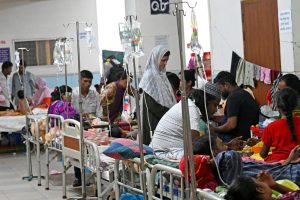For many, a transplant may finally be the end to suffering. However, rejection can still occur after the procedure.
Transplant rejection occurs when the recipient’s immune system views the donor’s tissue or organ as foreign and launches an attack to destroy the transplanted tissue. This occurs due to the detection of the donor’s unique set of proteins, known as human leukocyte antigen (HLA) proteins, found on the surface of the donor’s tissue cells.
How does the recipient’s immune system differentiate foreign cells from its own cells?
To protect the body from infections, our immune system must distinguish self-particles from non-self particles that do not arise from the body. This can include bacteria, viruses, other pathogens, or any other type of foreign organism or tissue from other species.
The body recognises foreign species via molecules called antigens which are cellular tags that differentiate one organism from another. The human leukocyte antigen (HLA) complex is a set of genes that encode proteins that differentiate foreign tissue from self-tissue. Everyone has a set of specific HLA proteins encoded on each cell of the body, based on their unique genetic makeup.
In the case of tissue and organ rejection, foreign HLA antigens from the donor are identified by the recipient’s white blood cells (lymphocytes), triggering a slew of immune activation events.
Chances of Transplant Rejection
Histocompatibility is the degree of similarity between the HLA genes of the donor and recipient. Before a transplant is conducted, a cheek swab and a blood test will be taken from both the donor and recipient. A histocompatibility antigen blood test will examine for HLA type matching to maximise the number of alleles compatible between donor and recipient. The more genetically compatible both people are, the higher the chances of the recipient’s immune system being more tolerant towards the foreign graft or organ.
Types of Transplant Rejection
There are three main clinical stages of graft rejection, dependent on the time frame.
1. Hyperacute rejection
Hyperacute rejection occurs within a few minutes after the transplants when the antigens of the donor and the recipient do not match. It is caused by the presence of pre-antibodies against the recipient’s cells that induce mainly two types of immune responses – complement activation and secretion of the von Willebrand procoagulant factor that cause platelets (a component of the blood) to stick together and clot blood vessels, preventing blood supply to the graft.
The donor’s tissue or organ must be removed immediately so that the recipient does not risk death.
2. Acute rejection
Acute rejection can happen anytime from the first week to 3 months after the transplant. This occurs when the recipient’s immune system identifies the tissue graft or organ as foreign and destroys it. It is very common in transplant cases. Hyperacute rejection and acute rejection differ in the presence of preformed antibodies that lead to immediate rejection.
Signs of acute rejection:
- High fever
- Increase in serum creatinine in the blood
- Swelling of the extremities
- Increase in blood pressure
- Decrease in urine output (in kidney transplants)
- Tenderness or pain over the transplant area
Early detection and prophylaxis can help to preserve the graft or organ by suppressing the immune system with immunosuppressive drugs.
3. Chronic rejection
Chronic rejection occurs after repeated episodes of acute rejection and takes place over many years. This occurs when using the recipient’s immune response constantly attacks the donor’s graft or organ, leading to persistent damage and rejection. It is characterised by the scarring of the tissue or organ, inflammation, and atrophy of the cells lining the arteries of the graft, leading to loss of function.
Finding the Best Donor
To prevent issues of rejection, these compatibility tests are carried out to maximise the chances of compatibility:
ABO blood group
Blood types of both donor and recipient must be compatible to avoid what is known as an ABO incompatibility reaction for graft or organ transplants. For example, people with Type B blood will react against people with Type A or Type AB blood. Transplanted grafts or organs will be rejected immediately if blood groups are not matched. This is mandatory for most cases except for haematopoietic stem cell transplants.
HLA Tissue Typing
Blood samples are taken from donors and recipients to check for histone compatibility. Family members are usually the first to be tested. The closer the genetic similarity, the lower the chances of rejection.
Cross Matching
Blood from the recipient is mixed with cells from the donor to check for the presence of the recipient’s antibodies against the donor’s cells. In the case of a positive reaction, the donor is unsuitable for transplant.
Serology screening
The immune status of both donor and recipient will be tested for the presence of infectious organisms such as Epstein-Barr Virus (EBV), cytomegalovirus (CMV) and HIV which can lead to life-threatening complications such as post-transplant lymphoproliferative disorders (PTLD) in haematopoietic stem cell transplantation and solid organ transplantations.
Immunosuppressive drugs
All patients are managed with immunosuppressive drugs (also known as immunosuppressants) to allow their immune systems to be more tolerant toward foreign grafts and organs. High amounts of drugs are administered before lower amounts of drugs are prescribed for maintenance.
Immunosuppressants affect the body systemically by reducing the immune function of the whole body. Therefore, patients become especially susceptible to opportunistic infections. These drugs also confer high amounts of toxicity which can lead to cardiovascular disease and stress on kidney health.











